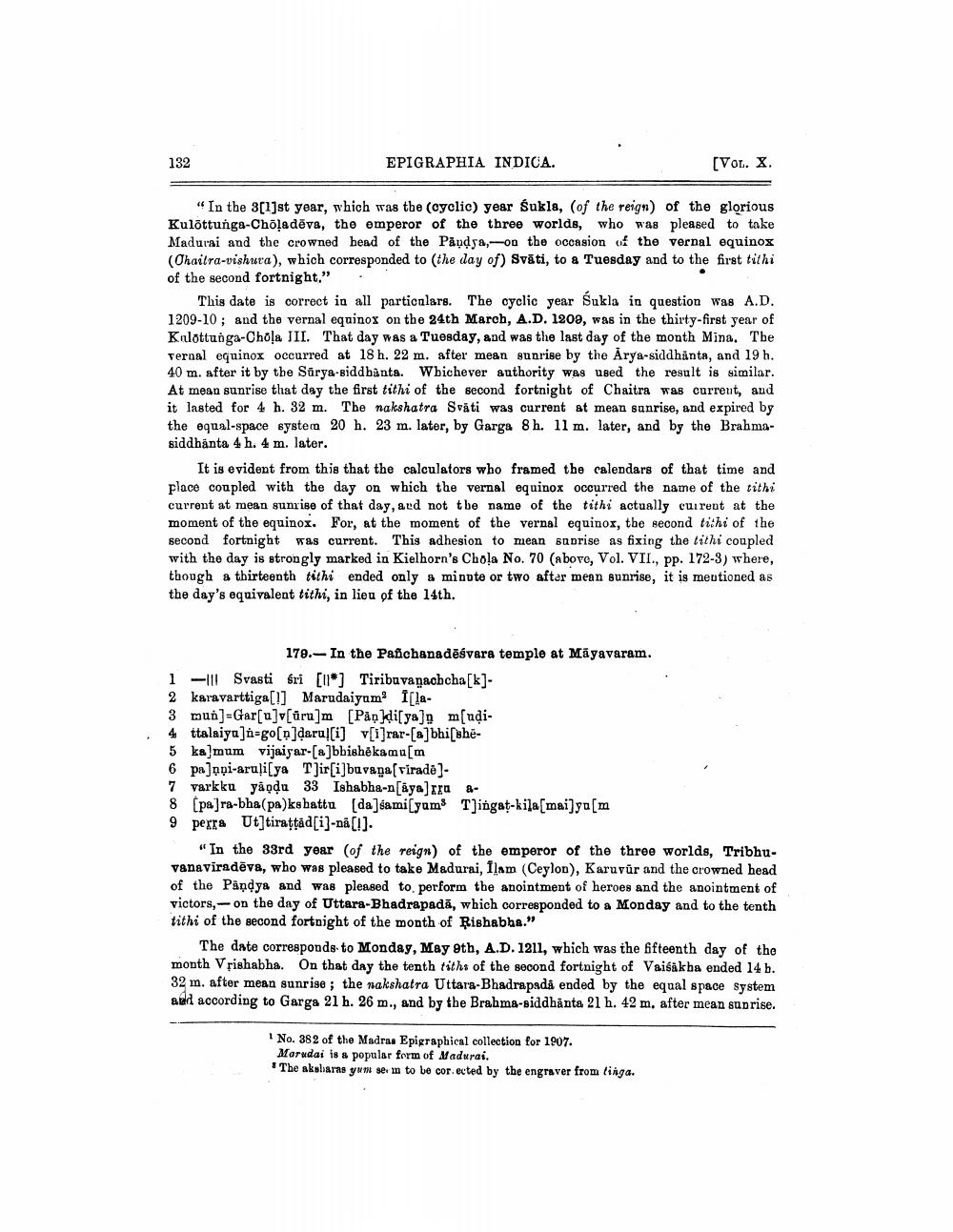________________
132
EPIGRAPHIA INDICA.
[Vol. X.
"In the 3[1]st year, which was the (cyclic) year śukle, (of the reign) of the glorious Kulõttunga-Choladēva, the emperor of the three worlds, who was pleased to take Madurai and the crowned bead of the Påndya, -on the occasion of the vernal equinox (Ohailra-vishura), which corresponded to the day of) Svāti, to a Tuesday and to the first tithi of the second fortnight."
This date is correct in all particolars. The cyclic year Sukla in question was A.D. 1209-10; and the vernal equinox on the 24th March, A.D. 1203, was in the thirty-first year of Kuulottunga-Chola III. That day was a Tuesday, and was the last day of the month Mina. The Ternal equinox occurred at 18 h. 22 m. after mean sunrise by the Arya-siddhanta, and 19 h. 40 m. after it by the Sārya-siddbånta. Whichever authority was used the result is similar. At mean sunrise that day the first tithi of the second fortnight of Chaitra was current, and it lasted for 4 h. 32 m. The nakshatra Svāti was current at mean sanrise, and expired by the equal-space systemu 20 h. 23 m. later, by Garga 8h. 11 m. later, and by the Brahmasiddhanta 4 h. 4 m. later.
It is evident from this that the calculators who framed the calendars of that time and place coupled with the day on which the vernal equinox occurred the name of the tithi current at mean sunrise of that day, and not tbe name of the tithi actually current at the moment of the equinox. For, at the moment of the vernal equinox, the second tithi of the second fortnight was current. This adhesion to mean suprise as fixing the tithi coupled with the day is strongly marked in Kielhorn's Chola No. 70 (above, Vol. VII., pp. 172-3) where, though a thirteenth tithi ended only a mindte or two after mean sunrise, it is meutioned as the day's equivalent tithi, in lieu of the 14th.
170.-In the Pafichanadēśvara temple at Māyavaram. 1 -III Svasti sri [11*] Tiribavaṇachcha[k]. 2 karavarttiga[1] Marudaiyam Isla3 mun]-Gar[u]y[ūru]m [Paldisya]n míudi4 ttalaiya]i=go[o]daru![i] v[i]rar-[a] bhi she5 ka}mum vijaiyar-[a]bbishēkama[m 6 palopi-aruli ya T Jir[i]buvaga virade). 7 varkku yiodu 33 Ishabha-n[aya)rra 48 [pa]ra-bha(pa)ksbattu [da]sami yums T)ingat-kila[mai]go[m 9 perra Ut]tirattad[i]-na[!].
"In the 33rd year of the reign) of the emperor of the three worlds, Tribhuvanaviradēva, who was pleased to take Madurai, Ilam (Ceylon), Karuvür and the crowned head of the Pandya and was pleased to perform the anointment of heroes and the anointment of victors,- on the day of Uttara-Bhadrapadă, which corresponded to a Monday and to the tenth tithi of the second fortnight of the month of Rishabha."
The date corresponds to Monday, May 9th, A.D. 1211, which was the fifteenth day of the month Vpishabha. On that day the tenth tiths of the second fortnight of Vaisakha ended 14 b. 32 m. after mean sunrise ; the nakshatra Uttara-Bhadrapadå ended by the equal space System and according to Garga 21 h. 26 m., and by the Brahma-siddhanta 21 h. 42 m. after mean suprise.
No. 38 2 of the Madras Epigraphical collection for 1907. Marudai is a popular form of Madurai. "The akslaras yun ser in to be cor. ected by the engraver from linga.




